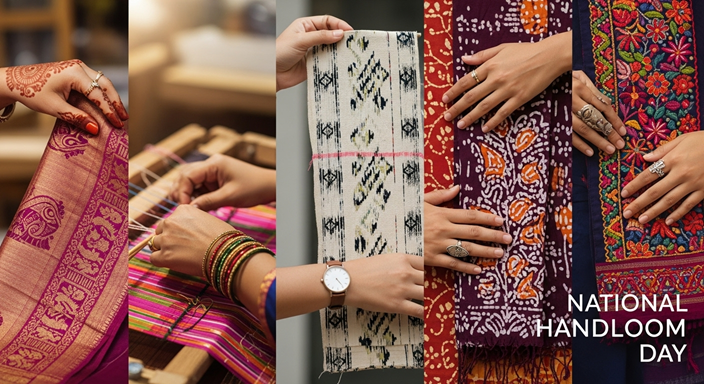Every year, August 7 is commemorated as National Handloom Day in India to honour the country’s rich textile heritage and the weavers who preserve it. It’s a celebration of indigenous craftsmanship, sustainable fashion, and rural empowerment. From the intricate Banarasi silks to the earthy khadi, the Indian handloom industry reflects the diverse cultural threads that bind the country together. On this day, we remember not only the historical role handlooms played in India’s independence movement but also their modern relevance in promoting eco-friendly, ethical, and artisanal fashion. National Handloom Day inspires citizens to wear and support local.
History of National Handloom Day
National Handloom Day was officially celebrated for the first time on August 7, 2015, by the Government of India, under the leadership of Prime Minister Narendra Modi. The date was specifically chosen to commemorate the Swadeshi Movement, which was launched on August 7, 1905, during the freedom struggle against British colonial rule.
The Swadeshi Movement called upon Indians to boycott foreign-made goods and revive local industries, especially handlooms and khadi textiles. The Ministry of Textiles took the initiative to formally recognise this date as National Handloom Day, to revive that nationalist spirit and pay tribute to India’s skilled weavers.
Since then, it has been celebrated annually across the country to highlight the contribution of the handloom sector in the socioeconomic development of India.
Importance of National Handloom Day
The significance of National Handloom Day lies in its deep cultural, economic, and patriotic roots:
-
Cultural Preservation: India’s handloom traditions are centuries old and regionally diverse. Celebrating this day safeguards these crafts from vanishing.
-
Economic Empowerment: The handloom industry is the second largest employment provider in rural India after agriculture, engaging over 35 lakh weavers.
-
Promotion of Sustainable Fashion: Handlooms are environment-friendly and sustainable, using natural fibres and dyes with minimal carbon footprint.
-
Reviving National Pride: The day reinforces our connection with the Swadeshi spirit and our commitment to Make in India.
-
Women Empowerment: A large percentage of weavers are women from rural and tribal backgrounds, making this sector crucial for gender-inclusive growth.
Significance of National Handloom Day
The handloom sector in India is not just a business—it’s a way of life, an art form, and a symbol of identity for many communities. By observing National Handloom Day:
-
Traditional crafts get visibility on national platforms.
-
Artisans receive recognition and government support.
-
The younger generation is educated about the value of indigenous weaving.
-
It promotes the revival of dying handloom styles through market exposure.
Handloom Day acts as a bridge between past and present, bringing ancient traditions into modern conversations around fashion, sustainability, and heritage.
Why National Handloom Day is Celebrated
National Handloom Day is celebrated to:
-
Pay tribute to handloom weavers and their timeless artistry.
-
Highlight the role of handlooms in India’s independence and their continued relevance.
-
Encourage citizens to choose handloom products over mass-produced goods.
-
Promote local economies and self-reliant India (Atmanirbhar Bharat).
-
Create awareness among urban populations about ethical consumerism.
-
Support the preservation of traditional knowledge and craftsmanship.
How National Handloom Day is Celebrated
The celebration of National Handloom Day has become increasingly vibrant and widespread. Here’s how it’s observed:
-
Fashion Shows & Exhibitions: Government bodies and fashion institutions organise handloom-themed fashion shows, highlighting the beauty of fabrics like khadi, Chanderi, Jamdani, and more.
-
Workshops & Seminars: Talks by experts, historians, and artisans are conducted on the history, techniques, and future of the handloom industry.
-
Social Media Campaigns: Hashtags like #MyHandloomMyPride, #VocalForLocal, and #HandmadeInIndia trend across platforms.
-
Retail Discounts and Promotions: Many handloom brands offer discounts and promote traditional collections to encourage buying local.
-
Celebrity Endorsements: Influencers and celebrities wear and promote handloom products, adding aspirational value to traditional wear.
-
School & College Events: Cultural programs, drawing competitions, and debates are held to instill love for heritage in students.
-
Government Recognitions: Awards and certificates are given to outstanding weavers and clusters.
Where National Handloom Day is Celebrated
Though National Handloom Day is officially an Indian observance, its impact is felt globally, especially where there is a strong Indian diaspora. Key regions include:
-
India: All states, especially West Bengal, Odisha, Tamil Nadu, Uttar Pradesh, Andhra Pradesh, Gujarat, and Assam, which have vibrant handloom traditions.
-
United States, United Kingdom, Canada: Through Indian cultural organizations and embassy events.
-
South East Asia: Countries like Singapore and Malaysia, home to large Indian-origin populations, also participate in exhibitions and cultural events.
Major cities like Delhi, Mumbai, Chennai, Kolkata, Hyderabad, Bengaluru, and Ahmedabad witness large-scale government and private sector participation.
Citizen Participation and Support
Citizens play a crucial role in making National Handloom Day a success:
-
Wearing Handloom: People are encouraged to wear handloom garments to school, college, and office.
-
Buying Local: Citizens are urged to support local artisans and cooperatives by purchasing handloom products.
-
Story Sharing: Individuals share pictures and stories of their favourite handloom pieces on social media, tagging artisans or brands.
-
Visiting Handloom Fairs: Many people attend melas and exhibitions, interact with weavers, and learn about the craft.
-
Volunteering: NGOs and students volunteer with handloom clusters to promote design innovation and digital marketing.
The collective action of citizens helps ensure that handloom traditions do not fade away in the age of fast fashion.
Theme for National Handloom Day 2025
While the official theme for 2025 will be announced by the Ministry of Textiles, a likely theme aligned with current national priorities is:
🧵 “Threads of Tomorrow: Weaving Sustainability & Heritage” 🧵
This theme would focus on:
-
Promoting eco-conscious consumption
-
Bridging the gap between tradition and innovation
-
Empowering the next generation of weavers
-
Enhancing the global appeal of Indian handlooms
10 Famous Quotes for National Handloom Day
-
“Khadi is not just a cloth; it is a movement.” – Mahatma Gandhi
-
“Wearing handloom is wearing a piece of art created by patience.”
-
“Support the loom, uplift the weaver.”
-
“Indian handloom is not a fashion trend; it’s a cultural treasure.”
-
“Each thread tells a story of heritage, hope, and hard work.”
-
“Buy local, wear handmade, love Indian.”
-
“Weaving is not just a skill—it is a heartbeat of rural India.”
-
“Our culture is woven into every thread of handloom fabric.”
-
“Handloom is elegance born from tradition.”
-
“Celebrate India, celebrate its weaves.”
Frequently Asked Questions (FAQs) on National Handloom Day
Q1. When is National Handloom Day celebrated?
A: It is celebrated annually on August 7.
Q2. Why was August 7 chosen for National Handloom Day?
A: August 7 marks the launch of the Swadeshi Movement in 1905, which promoted indigenous goods including handlooms.
Q3. Who started National Handloom Day?
A: It was initiated by the Government of India in 2015 under Prime Minister Narendra Modi.
Q4. What is the aim of National Handloom Day?
A: To promote the handloom industry and encourage the public to buy and wear handloom products.
Q5. What is the significance of handloom in India?
A: It is a symbol of Indian heritage, sustainability, and rural empowerment.
Q6. How can we support handloom artisans?
A: By purchasing handloom products, spreading awareness, and sharing their stories on social media.
Q7. Which states are famous for handloom in India?
A: States like Tamil Nadu, West Bengal, Assam, Gujarat, Odisha, Uttar Pradesh, and Andhra Pradesh.
Q8. Is handloom eco-friendly?
A: Yes, handlooms use natural dyes and fibres, making them sustainable and environmentally safe.
Q9. What are some famous Indian handloom fabrics?
A: Chikankari, Jamdani, Pochampally, Banarasi, Muga silk, Kanjeevaram, Kalamkari, and more.
Q10. Are there government schemes for handloom weavers?
A: Yes, schemes like Pehchan card, Yarn Supply Scheme, Mudra loans, and marketing assistance are provided.
Conclusion
National Handloom Day is more than just a celebration—it is a call to action. It reminds us to take pride in our roots and support the hands that preserve India’s timeless legacy. By embracing handloom, we not only encourage artisans but also make a sustainable, stylish, and ethical choice.
As India marches forward in the age of globalisation, let’s hold onto the threads of our identity—threads spun with care, love, tradition, and craftsmanship.
Let August 7, 2025, be another powerful milestone in our journey towards preserving Indian handlooms for generations to come.
|
!!! Stay Updated !!! 👉 Follow and Join us on 👈 📰 Trending News | 📢 Important Alerts | 💼 Latest Jobs LinkedIn | Threads | Facebook |Instagram | Tumblr 📱 Follow us daily & never miss an update 📱 |

Someshwar Chowdhury is a seasoned Chartered Mechanical Engineer, Educator, and Technology enthusiast with over a decade of experience in engineering education and consultancy. Someshwar is also an active blogger, trainer, and member of professional bodies like ISHRAE and GREEN ADD+. When not teaching or consulting, he enjoys blogging, music, and exploring green technologies.
Discover more from Today's Significance
Subscribe to get the latest posts sent to your email.
